-
The Fatimid Exhibition
[Back to Fatimid Exhibition]
The Heritage Society Presents... Back to Heritage F.I.E.L.D - First Ismaili Electronic Library and Database
Discovering Cairo in the Footsteps of The Fatimids Explore Cairo, the exotic city of the Fatimids, as Paris pays tribute, presenting an exhibition on this ancient Egyptian civilisation. By Jean-Claude Perrier
Photos: Jacques Denarnaud
The French may have a reputation for being weak on geography and it can sometimes even extend to history, for example the history of Egypt which, when seen from a French point of view, often makes a great leap from the time it was annexed to the Roman Empire by Agustus in 30 BC to the time the Republican armed forces landed in 1798, a key yet brief moment in the country’s history which only lasted three years.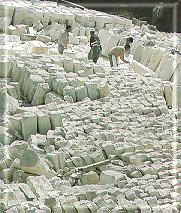
The Fatimid Wall It is almost as if the pharaohs in their mastabas, hypogean underground or pyramids had cast a spell over the country and their descendants.
As the woods cannot be seen for the trees, so ancient Egypt, having risen from past oblivion and in great style since the 19th century with accomplices such as Vivant Denon, Champollion and Mariette, has now cast its shadow over all the intervening civilisations.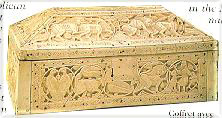
Jewellry box with scenes from hunt,
made of ivory, 11th - 12th centuryMost western travellers, wrapped up in packages by tour-operators, see Cairo as a short stopover, visiting the pyramids, the Gizeh Sphinx, the national museum with the mummies and treasure of Tutankhamen, as a latter day sorting centre for the wonders of the pharaohs of upper and lower Egypt.
Such an approach is utterly unjust and the exhibition on the Fatimid treasures of Cairo currently being presents a the Insitut du Monde Arabe in Paris is a timely reminder of this. Here is an opportunity to discover and exciting period in the history of Egypt, the time of the Ismaili Chiite caliphs who had travelled from western north Africa and ruled over the country from 969 AD (when Al-Qahira, “The Victorious”, was founded) until 1171.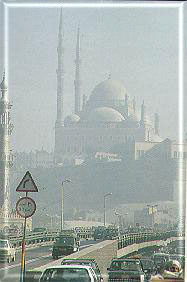
View from the Citadelle Cairo cannot be compared to any other city in the world: it is a noisy, colourful, sprawling, anarchic megalopolis with a population of twelve million, spreading out into residential suburb which are gradually being swallowed up by the city. It is the capital of modern Egypt and home to 20% of the country’s population.
Today, the Fatimid monuments of Cairo are bound by the lines of a large imaginary square, stretching west to the avenue of Port Said (the address of the quite magical and peaceful Islamic Art Museum which has loaned most of the 250 pieces presented in the Paris exhibition), then north and east along a boundary partly marked by a wall with a number of monumental gates, such as Bab El Futuh, and then south as far as the street named Ahmed Maher with the Zuweila gate and the famous bazaar of Khan el Khallili, as well as the grand mosque and university of El Azhar, the leading authority in the Muslim world which was originally founded in 988.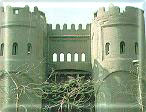
Bab-el Futuh
A labyrinth of small, densely populated streets covered in dust or mud, depending on the weather, is home and/or workplace for a vast population. Private dwellings and shops have sprung up in total anarchy, as have mosques and masdrasas (the Koranic schools), similar to the emergence of Christian cathedrals in the middle ages. To avoid getting lost in such chaos, follow the street of El Muizz Din Allah, which runs across the district from north to south. The buildings are often in a poor state of repair, despite recent campaigns to save and restore them; every different architectural period can be seen in a haphazard assortment.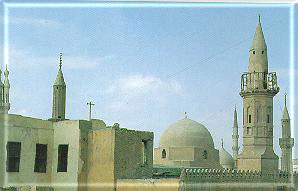
View from the Mosque of Al-Azhaar University A few hundred metros further on, the visitor walks past the Fatimid wall dating from 1087, a Mameluke mosque (the Mamelukes reigned over Egypt from 1250 to 1517) and a sabil, the fountain beneath a Koranic school dating from the Ottoman period, which preceded the French conquest of the country, the bicentenary of which is being celebrated, albeit controversially, this year.
The Ayyubides, who reigned from 1751 to 1250, after defeating the Fatimids, left little evidence of their presence: instead of building and decorating monuments, they were more interested in erasing traces of the exuberant Fatimid period, for example the figurative relief work featuring animals and human beings intertwined with verses from the Koran or foliage scrolls.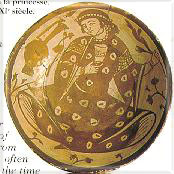
Cup of the Princess,
Ceramic 11th CenturyIronically it was the fanaticism of the Ayyubides, who restored strict orthodox Sunnism to Egypt, which ensured that many Fatimid works of art can still be admired today: workers were instructed to use the same pieces of wood, marble and ivory, simply turning them around to hide the ornamental details. As a result, modern archaeologists conducting digs have simply turned them around the other away to find the splendour of the original piece fully preserved. Such are the quirks of history.
The Cairo of the Fatimids is the historic part of Cairo as it stands today. Except in Khan El Khallili, here everyone can find everything imaginable, including the last surviving glass-blowers in the city and traditional perfume-makers who, on request, will combine scents to produce a smooth and totally original fragrance, and where people bargain freely, very few tourists are seen.
A simple stroll is an exhausting but exciting adventure. At any and every moment, at any and every point, there are tooting horns, cars backfiring, stands and street sellers calling out to tout their wonderful wears, for example the hat-maker who is the last to make traditional white, black or maroon chechias, the preferred style of King Faruk who last won the throne in 1952; or there is the fascinating book-binder near the mosque of El-Azhar and the attractive house of Harawi, restored by a French mission and offering “notebooks” of every size, bound in semi-shagreen bearing the customer’s name etched in gold.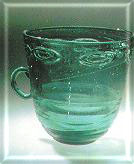
Blue glass mug, 10th century The visitor may very well feel that he has been transported back to the 19th century, when travellers felt duty bound to keep a travel log of personal observations and impression or even sketches.
By the time the visitor has finished his excursion, filled with colours, fragrances and striking impressions, it is time to have a break and a snack at the Café El-Fishawy in the heart of the bazaar, a 19th century bistro decorated in Ottoman style (reminiscent of scenes on the edge of the Bosporus), to enjoy the atmosphere here where the citizens of Cairo gather to sip mint tea and nibble on pistachios while puffing on a famous chicha or narghile pipe, sending up clouds of aromatic smoke scented with apple or rose.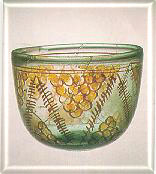
Bowl, 10th - 12th century Time certainly seems to have stood still, caught in ancient times, or at least to be moving slowly, at the same rate as the Nile which has been flowing just short distance away for thousands of years and was part of the past of the Fatimids.
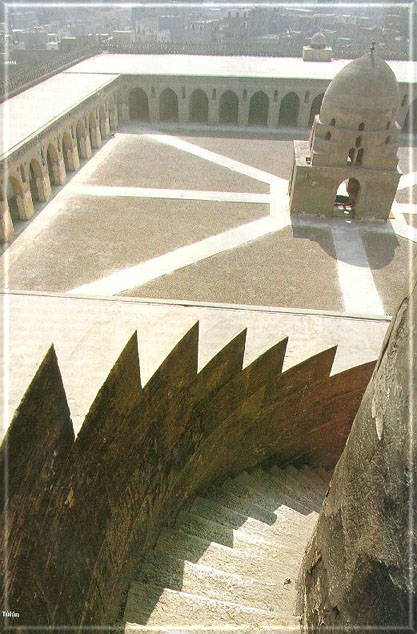
Ibn Tulun Mosque
[ Back to the Heritage Page]
[ Back to Selected Readings]
-